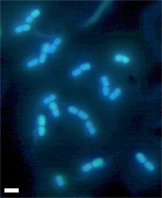The genus Psychrobacter is comprised primarily of halotolerant, psychrophilic to mesophilic, aerobic, non-motile, Gram-negative coccobacilli and was first described as a separate genus within the gamma-proteobacteria in 1986 [1] . Psychrobacter species are capable of reproducing at temperatures ranging from -10°C to 40°C. Psychrobacter species have been isolated primarily from low temperature marine environments including Antarctic sea ice, ornithogenic soil, and sediments; the stomach contents of the Antarctic krill Euphausia; sea water (NW pacific ocean, 300 m depth); the deep sea; and the internal tissues of a marine ascidian [2-5] . Psychrobacter species have also been isolated from a pigeon feces bioaerosol, a poultry carcass, fermented sea food, human blood and tissues, and the lungs of an infected lamb [1, 6-8] . Psychrobacter cryohalolentis K5 (formerly known as Psychrobacter cryopegella) was isolated from a cryopeg (saline water lens) within 40 thousand-year-old Siberian permafrost where the in situ temperature is -9 to -11°C [9] . The cryopeg samples were obtained from the Kolyma-Indigirka lowland, Siberia by David Gilichinsky (Russian Academy of Sciences, Pushchino, Russia). Psychrobacter cryohalolentis K5 is a small, non-motile coccoid rod often found in pairs. On marine agar it produces smooth, non-pigmented colonies. This strain was selected for sequencing based on its ability to reproduce at -10°C with a generation time of 39 days, rapid growth at low temperatures, close relationship to Psychrobacter 273-4, and the different permafrost niche it was isolated from (cryopeg) relative to Psychrobacter 273-4. Additional studies of Psychrobacter cryohalolentis K5 have examined critical temperature, growth efficiency, and protein expression at subzero temperatures [10, 11] . Specific genes and molecular characteristics required for low-temperature growth can be identified via comparative genomics, which is aided by the comparison of close relatives. In addition, genomic information will greatly enhance the interpretation of protein expression at subzero temperatures already examined in this organism. The long-term survival of microorganisms at low temperatures is relevant to the search for and study of microbes that survive and grow in cold and sub-zero environments (deep sea, Antarctic and Arctic permafrost and endolithic environments, Mars, etc.). Growth and survival of low temperatures is also relevant to food storage and processing, general mechanisms of bacterial survival, and stress responses of microorganisms. 1. Juni, E. and G.A. Heym, Psychrobacter immobilis gen. nov., sp. nov.: Genospecies composed of Gram-negative, aerobic, oxidase-positive coccobacilli. Int. J. Syst. Bacteriol., 1986. 36 (3): p. 388-391. 2. Romanenko, L.A., et al., Psychrobacter submarinus sp. nov. and Psychrobacter marincola sp. nov., psychrophilic halophiles from marine environments. Int. J. Syst. Evol. Micr., 2002. 52 : p. 1291-1297. 3. Bowman, J., D. Nichols, and T. McMeekin, Psychrobacter glacincola sp. nov, a halotolerant, psychrophilic bacterium isolated from Antarctic sea ice. Syst. Appl. Microbiol., 1997. 20 (2): p. 209-215. 4. Yumoto, I., et al., Psychrobacter okhotskensis sp. nov., a lipase-producing facultative psychrophile isolated from the coast of the Okhotsk Sea. Int J Syst Evol Microbiol, 2003. 53 (6): p. 1985-1989. 5. Maruyama, A., et al., Phylogenetic analysis of psychrophilic bacteria isolated from the Japan Trench, including a description of the deep-sea species Psychrobacter pacificensis sp. nov. Int. J. Syst. Evol. Micr., 2000. 50 : p. 835-846. 6. Vela, A.I., et al., Psychrobacter pulmonis sp. nov., isolated from the lungs of lamb. Int. J. Syst. Evol. Micr., 2003. 53 : p. 415-419. 7. Yoon, J.-H., K.H. Kang, and Y.-H. Park, Psychrobacter jeotgali sp. nov., isolated from jeotgal, a traditional Korean fermented seafood. Int. J. Syst. Evol. Micr., 2003. 53 : p. 449-454. 8. Kampfer, P., et al., Psychrobacter faecalis sp. nov., a new species from a bioaerosol originating from pigeon faeces. System. Appl. Microbiol., 2002. 25 : p. 31-36. 9. Bakermans, C., et al., Reproduction and metabolism at -10°C of bacteria isolated from Siberian permafrost. Environ. Microbiol., 2003. 5 (4): p. 321-326. 10. Bakermans, C. and K.H. Nealson, Relationship of critical temperature to macromolecular synthesis and growth yield in Psychrobacter cryopegella. J. Bacteriol., 2004. 186 (8): p. 2340-2345. 11. Bakermans, C., et al., Cold acclimation proteins expressed at subzero temperatures by a Psychrobacter isolated from Siberian permafrost. Environ. Microbiol., 2004. Submitted . |
||
|
||
Psychrobacter cryohalolentis K5

